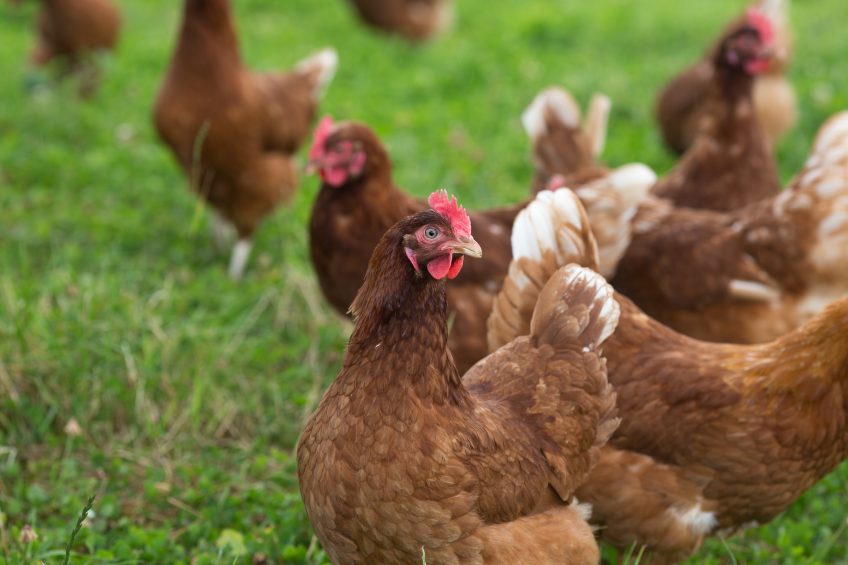Getting ranges ready for winter

Autumn is well and truly upon us and now is a good time to prepare free range sites for the winter months ahead. Bowler Eggs’ sales director Andrew Watson offers some tips from his own 18,000-layer unit in Derbyshire.
Winter is approaching, and once the weather turns daily routines begin to be hampered by the rain, frost, wind and shorter day lengths making repairs and sorting out drainage issues a more arduous task, according to Bowler Eggs’ Andrew Watson.
It is better to get ahead and prepare the unit now while temperatures are high enough to grow grass for reseeds and there is enough day length to carry out checks and get through the autumn job list.
Paddock repair
After the dry summer, some paddocks may be dotted with dust-bathing sites and hollows. While these don’t look significant in the dry weather they quickly become obvious when they fill with winter rain. As all free-range egg producers know, hens will ignore best efforts to provide them with the cleanest drinking water and make a beeline for these muddy potholes.
This can lead to problems for the flock, as mud and water can harbour parasites. It is best to fill them in and reseed the patch while the weather is still dry and warm enough to get some grass growth.
For the same reason, it is also a good time to reseed the bare areas around poultry houses, especially outside pop-holes. Again, these areas, which are exposed to the heaviest use, can become muddy and provide a haven for disease and parasites.
On our unit we use a hard-wearing sports ley grass mix within 30-40m of the pop-holes to withstand the extra pressure from the birds. The mix includes varieties like fescues which are deep-rooted and help to create good drainage near the soil surface. It means the birds’ feet are drier and less likely to bring mud, soil and parasites into the housing when it is raining. Beyond the 40m mark it makes more economic sense to use a cheaper permanent ley mix.
All of these new grass areas will benefit from some levelling and light cultivation, using harrows to create a tilth before sowing and a roller. But it is important to avoid the common mistake of cultivating too deeply which can bring up soil-borne parasites.
While the grass is growing, keeping the birds off the delicate sward is essential to allow the roots to develop and a paddock-based system is a big advantage.
Our farm has 4 units of 4,500 birds with 3 paddocks around each of the buildings. It means the flock can be moved on to 2 of the paddocks for up to 3 months at a time allowing the third to regrow and the area around the pop-holes to recover.
As well as allowing the regrowth – which is essential for the look of the unit and the customer’s perception – it breaks up the worm cycle, reducing the burden dramatically. The autumn growth period is also a good opportunity to replace any trees which have died back or fallen to ensure that cover is maintained for the coming years.

Drainage tasks
Drainage maintenance is of the utmost importance because standing water and mud allow worms and disease to thrive. Checking that outlets and ditches are clear and allowing water to flow freely off the site is a regular task. But this time of year represents a decent window before winter to carry out more significant work, removing any summer vegetation and overgrowth and perhaps improving the existing drainage system. The most important element is to ensure that the drainage is effective around the pop-holes to prevent mud and moisture entering the housing.
Putting in a French drain – a perforated pipe, backfilled to the surface with stones – would be a useful approach to remove water before the winter rains set in.
Bowler buildings have verandas which provide a mesh walkway and cover to keep feet and feathers dry which is an investment well worth considering.
Other essential maintenance tasks are to check that downspouts and guttering are clear and unbroken so that when the rain does come, it is transported away from the area around the unit.
Repairing and replacing fences
The lack of wild food available means predators and vermin are more determined to get into the paddocks. That means checking fence-lines and perhaps repairing or even replacing them with something more robust this winter.
Bowler Eggs has moved away from temporary fencing to a more traditional wire and wooden post system.
With a flexible wire system the unit had poor bird and predator control.
Instead Bowler has installed a wire mesh made by Tornado which has a close horizontal and vertical spacing. It is 1.5m high and of a relatively light gauge, making it easier to handle. This is buried into the soil to keep out the digging predators with additional security provided by three strands of electric wire running along the top.
Whatever the preferred choice of fencing, it is still necessary to trim back hedges and trees to remove any overhanging branches which may fall and damage the fence in the winter.
Gateway repairs
Gateways need a lot of attention because their use throughout the previous seasons can leave deep ruts which fill with water and make access difficult. The ruts also leave gaps beneath gates making them open pathways for predators. One way to tackle this is to put down hardcore but it is not ideal because it can be uneven and dislodge in muddy conditions. At Bowler we put down 2 or 3 railway sleepers under the gates which provides a solid, flat entrance and limits the gaps. These are levelled up in the autumn if any movement has occurred.
Ventilation checks and adjustments
Other jobs on our list are to check hinges on ventilation flaps and other openings to ensure they are working freely. Any powered equipment like fans, manure belts and nestbox motors are run up to speed to ensure they are working correctly. Ventilation fans should be regularly powered up because they can be idle for longer periods in the winter months and it is worth ensuring a motor has not stuck or burnt out.
As the autumn progresses manual air inlets should be checked especially when cold, frosty periods are forecast.
Modern control systems have seasonal presets. But it is still worth checking these settings are accurate because the lower night-time temperatures can cause cold air to pool at bird level if fans are not correctly adjusted. This may lead to chilling especially when there are draughts or the birds come into the house wet. Conversely, producers who use temperature-based ventilation systems must be careful that fans don’t shut down altogether on particularly cold nights. It may be necessary to adjust thermostats to ensure fans comes on for short periods to counter build ups of CO2, moisture or ammonia.
Feed, water and egg weights
The onset of autumn is also a time when water lines may need a thorough clean and maintenance. Biofilms will have built up through the warmer, summer days and the lurking bacteria represent a big threat to flocks if not tackled.
It is also worth checking that frost protection for pipelines is adequate and has not degraded over time on older units. Any degradation or damage should be repaired – it is not worth risking frozen pipes.
In cold weather, daily feed intakes can increase by 10-15% in laying hens leading to larger egg sizes particularly when birds are still on a higher specification summer feed ration.
The increasing egg size can see birds become deficient in nutrients and may then lead to feather pecking and poorer quality shells. The switch from summer to winter may also see a reduction in fibre intake as grass consumption falls. One way of remedying this is to buy-in and provide lucerne bales for the hens to pick at in the housing.
Red mite control
Red mites are notoriously difficult to eliminate from cracks and crevices in the housing. The colder months are often seen as a reprieve because the mites are less active and efforts to tackle them are reduced. However, the opposite is true, this time of year offers the best chance of eradicating, or at least, significantly reducing the numbers of this persistent parasite. Hitting them while they are down will have a knock-on effect, limiting numbers at the start of the next population growth when the weather changes in the spring.
Biosecurity measures
Ensuring biosecurity is at its highest level is a vitally important autumn task as migratory birds fly in and bring a heightened risk of avian influenza as they do so.
Extra vigilance among all staff and a rigorous approach to hygiene at gates and between, paddocks and houses will help to limit risks. Boot dips must be regularly replenished and covered when not in use to stop dilution of the disinfectant in the rain. Visitors must adhere to the same rigorous procedure and all movements on to the unit must be recorded.
Regular website checks and discussions with the farm’s vet will help identify any increased risks of disease. All staff should be briefed on the farm’s contingency plan so that everyone knows what to do if the worst scenario develops.
Join 31,000+ subscribers
Subscribe to our newsletter to stay updated about all the need-to-know content in the poultry sector, three times a week. Beheer
Beheer











 WP Admin
WP Admin  Bewerk bericht
Bewerk bericht